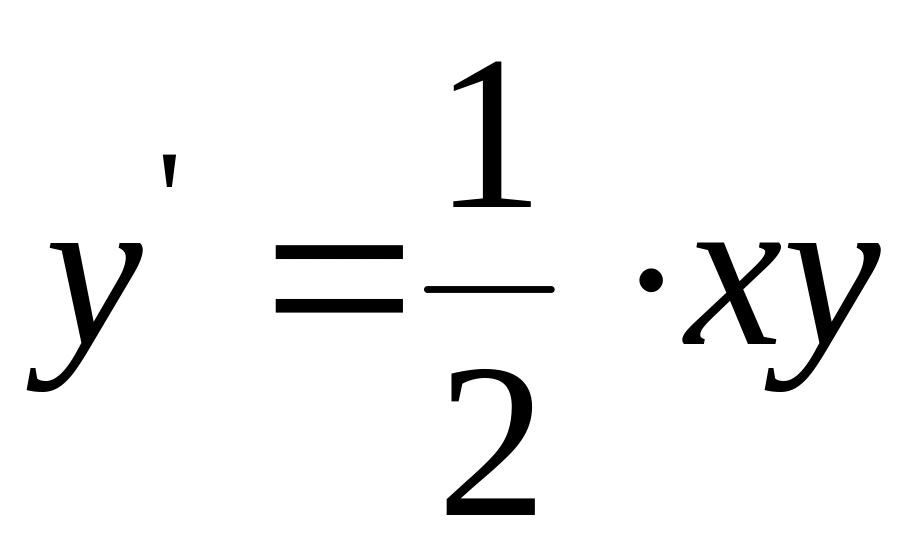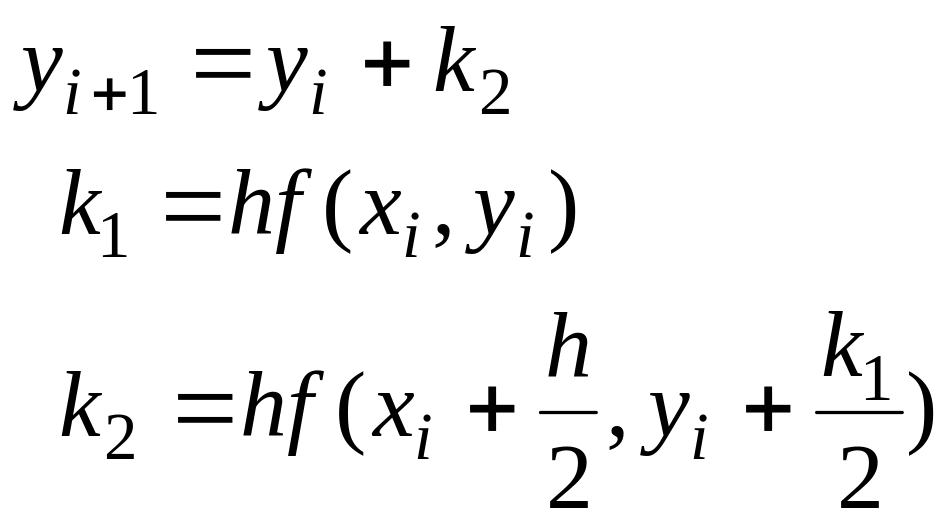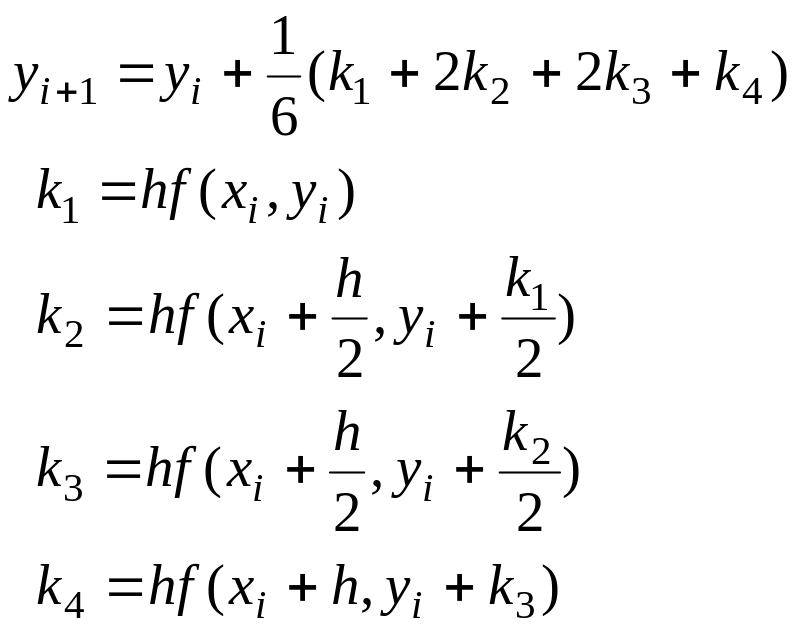
- •Contents
- •Introduction
- •Syllabus
- •Error and Accuracy of Calculations
- •Practise Part 1. Error and Accuracy of Calculations
- •Part 2. Numerical Integration
- •Part 3. Solution of Linear Algebraic Equations
- •Part 4. Solution Methods of Non-Linear Equations
- •Part 5. Integration of Ordinary Differential Equations
- •Table 5.2 Summary of important information
- •Part 6. Interpolation and Extrapolation of Functions
- •Computer labs
- •To the Student
- •The laboratory tasks Lab 1. Numerical Integration.
- •Variant 3. Numerically evaluate the following definite integral accurate to 4 significant digits.
- •Variant 4. Evaluate the integral from Var. 3 using Simple Monte Carlo approximation. Lab 2. Solution of Linear Algebraic Equations.
- •Variant 2. Solve the linear system from Var. 1 using Jacobi iteration. Check your results.
- •Variant 3. Solve the linear system from Var. 1 using Gauss - Seidel iteration. Substitute your results back into the original equations to verify your solution.
- •Lab 3. Solution Methods of Non-Linear Equations.
- •Lab 4. Integration of Ordinary Differential Equations.
- •Lab 5. Interpolation and Extrapolation of Functions.
Part 5. Integration of Ordinary Differential Equations
TABLE 5.1 Comparison of the characteristics of alternative methods
Method |
Starting Values |
Ease of Changing Step Size |
Global Error |
One step |
|
|
|
Euler's |
1 |
Easy |
O(h) |
Midpoint |
1 |
Easy |
O(h2) |
Fourth – order RK |
1 |
Easy |
O(h4) |
Multistep |
|
|
|
Fourth – order Adams |
4 |
Difficult |
O(h5) |
Table 5.2 Summary of important information
Method |
Formulation |
Errors |
Euler (First – order RK) |
|
Local error O(h2) Global error O(h) |
Midpoint method |
|
Local error O(h3) Global error O(h2) |
Classic fourth – order RK |
|
Local error O(h5) Global error O(h4) |
Fourth – order Adams |
Predictor: (fourth Adams - Bashforth)
Corrector: (fourth Adams - Moulton)
|
Local error O(h5) Global error O(h4) |
Example 1
Use Euler's method to
numerically integrate:
![]() from
x = 0
to x = 1
with a step size of: a) h
= 0.2, b) h
= 0.1. Compute percent relative errors for the numerical
results. The initial condition at x
= 0 is
y
= 1. Recall that the
exact solution is given by
from
x = 0
to x = 1
with a step size of: a) h
= 0.2, b) h
= 0.1. Compute percent relative errors for the numerical
results. The initial condition at x
= 0 is
y
= 1. Recall that the
exact solution is given by
![]() .
.
Solution. a)
Equation
![]() can be used to implement Euler's method: the slope estimate at x
= 0 and
y = 1
is f(0,1)
= 1.
can be used to implement Euler's method: the slope estimate at x
= 0 and
y = 1
is f(0,1)
= 1.
Therefore,
![]() .
.
The true solution at x
= 0.2 is
![]() .
.
Thus, the error is
![]() .
The computation is repeated, and the results are compiled in Table
5.3.
.
The computation is repeated, and the results are compiled in Table
5.3.
TABLE 5.3.
x |
ytrue |
yEuler |
t, % |
||
h = 0.2 |
h = 0.1 |
h = 0.2 |
h = 0.1 |
||
0 |
1.0 |
1.0 |
1.0 |
|
|
0.1 |
1.095445 |
|
1.1 |
|
-0.41 |
0.2 |
1.183216 |
1.2 |
1.191818 |
-1.4 |
-0.72 |
0.3 |
1.264911 |
|
1.277438 |
|
-0.98 |
0.4 |
1.341641 |
1.373333 |
1.358213 |
-3.2 |
-1.22 |
0.5 |
1.414214 |
|
1.435133 |
|
-1.46 |
0.6 |
1.48324 |
1.531495 |
1.508966 |
-4.8 |
-1.70 |
0.7 |
1.549193 |
|
1.580338 |
|
-1.97 |
0.8 |
1.612452 |
1.681085 |
1.649784 |
-6.9 |
-2.26 |
0.9 |
1.67332 |
|
1.71778 |
|
-2.59 |
1.0 |
1.732051 |
1.826949 |
1.784771 |
-9.5 |
-2.95 |
Example 2
Use a) the midpoint, and b) the fourth–order Adams methods to solve problem (Example 1) with h = 0.1.
Solution. a) The first step in the midpoint method is to compute
![]() .
The second step is to compute
.
The second step is to compute
![]() .
Therefore,
.
Therefore,
![]() .
The computation is repeated, and the results are summarized in Table
5.4.
.
The computation is repeated, and the results are summarized in Table
5.4.
b)
A popular multistep method based on the Adams integration
formulas uses the fourth-order Adams-Bashforth formula as the
predictor and the fourth-order Adams-Moulton formula as the corrector
(see Table 5.2). Because Adams’s methods are not self-starting, we
depend upon one step method (midpoint) to get the four initial slopes
![]() and
and
![]() (see Table 5.4).
(see Table 5.4).
TABLE 5.4.
x |
ytrue |
ymidpoint |
yAdams |
fi |
t, % |
|
midpoint |
Adams |
|||||
0 |
1.0 |
1.0 |
|
1.0 |
|
|
0.1 |
1.095445 |
1.095476 |
|
0.912907 |
-0.003 |
|
0.2 |
1.183216 |
1.183298 |
|
0.84526 |
-0.007 |
|
0.3 |
1.264911 |
1.265057 |
|
0.79077 |
-0.012 |
|
0.4 |
1.341641 |
1.34186 |
1.341809 |
0.745599 |
-0.016 |
-0.013 |
0.5 |
1.414214 |
1.414516 |
1.414407 |
0.707398 |
-0.021 |
-0.014 |
0.6 |
1.48324 |
1.483638 |
1.483465 |
0.674549 |
-0.027 |
-0.015 |
0.7 |
1.549193 |
1.549702 |
1.549457 |
0.645915 |
-0.033 |
-0.017 |
0.8 |
1.612452 |
1.613088 |
1.612761 |
0.620674 |
-0.039 |
-0.019 |
0.9 |
1.67332 |
1.674106 |
1.673684 |
0.598213 |
-0.047 |
-0.022 |
1.0 |
1.732051 |
1.733012 |
1.732481 |
0.578066 |
-0.056 |
-0.025 |
Problems
Solve the following initial-value problem analytically over the interval from
 to 1:
to 1:  where
where
 .
Plot the solution.
.
Plot the solution.Use the a) Euler, and b) midpoint methods with
 to solve Prob. 1. Plot the results on the same graph to visually
compare the accuracy for the two numerical methods.
to solve Prob. 1. Plot the results on the same graph to visually
compare the accuracy for the two numerical methods.Solve the following initial-value problem from
 to 5:
to 5:
 .
Use a step size of 0.5 and initial value of
.
Use a step size of 0.5 and initial value of .
Obtain your solutions using the following techniques: a) the
fourth-order RK method, and b) the fourth-order Adams method.
Compare and discuss the results.
.
Obtain your solutions using the following techniques: a) the
fourth-order RK method, and b) the fourth-order Adams method.
Compare and discuss the results.




